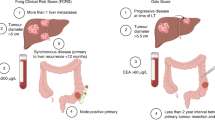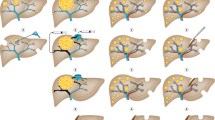Abstract
Resection and liver transplantation are considered effective treatments for early-stage hepatocellular carcinoma (HCC). As data from randomized trials are lacking, the choice of technique is controversial. Retrospective analyses suggest that for patients with suboptimal liver function, transplantation is the preferred treatment. For patients with preserved liver function and HCC within the Milan criteria, the overall survival rate is similar for both techniques; therefore resection is the preferred treatment. For tumours beyond the Milan criteria but within acceptable expanded criteria, transplantation has a more favourable outcome than resection. As liver grafts are in short supply, resection followed by transplantation once intrahepatic recurrence is detected would spare patients with favourable or very aggressive tumours from transplantation and enable patients with moderately aggressive tumours to undergo timely transplantation. Currently, resection and transplantation are considered complementary in the management of HCC. Expanding the transplantation and resection criteria of HCC needs to be investigated.
This is a preview of subscription content, access via your institution
Access options
Subscribe to this journal
Receive 12 print issues and online access
$209.00 per year
only $17.42 per issue
Buy this article
- Purchase on Springer Link
- Instant access to full article PDF
Prices may be subject to local taxes which are calculated during checkout

Similar content being viewed by others
References
International Agency for Research on Cancer. Liver cancer incidence, mortality and prevalence worldwide in 2008 [online], (2012).
Roskams, T. & Kojiro, M. Pathology of early hepatocellular carcinoma: conventional and molecular diagnosis. Semin. Liver Dis. 30, 17–25 (2010).
Torimura, T. et al. Mechanism of fibrous capsule formation surrounding hepatocellular carcinoma. Immunohistochemical study. Arch. Pathol. Lab. Med. 115, 365–371 (1991).
Kojiro, M. in Pathology of Hepatocellular Carcinoma 31–49 (Blackwell Publishing, Malden, 2006).
Zhu, L. X., Wang, G. S. & Fan, S. T. Spontaneous rupture of hepatocellular carcinoma. Br. J. Surg. 83, 602–607 (1996).
O'Malley, M. E., Takayama, Y. & Sherman, M. Outcome of small (10–20 mm) arterial phase-enhancing nodules seen on triphasic liver CT in patients with cirrhosis or chronic liver disease. Am. J. Gastroenterol. 100, 1523–1528 (2005).
Yang, Z. F., Poon, R. T., To, J., Ho, D. W. & Fan, S. T. The potential role of hypoxia inducible factor 1α in tumor progression after hypoxia and chemotherapy in hepatocellular carcinoma. Cancer Res. 64, 5496–5503 (2004).
Man, K. et al. Molecular signature linked to acute phase injury and tumor invasiveness in small-for-size liver grafts. Ann. Surg. 251, 1154–1161 (2010).
Penn, I. The effect of immunosuppression on pre-existing cancers. Transplantation 55, 742–747 (1993).
Fan, S. T. et al. Continuous improvement of survival outcomes of resection of hepatocellular carcinoma: a 20-year experience. Ann. Surg. 253, 745–758 (2011).
Kubota, K. et al. Measurement of liver volume and hepatic functional reserve as a guide to decision-making in resectional surgery for hepatic tumors. Hepatology 26, 1176–1181 (1997).
Takayama, T. & Makuuchi, M. Preoperative portal vein embolization: is it useful? J. Hepatobiliary Pancreat. Surg. 11, 17–20 (2004).
Gaba, R. C. et al. Radiation lobectomy: preliminary findings of hepatic volumetric response to lobar yttrium-90 radioembolization. Ann. Surg. Oncol. 16, 1587–1596 (2009).
Ishizawa, T. et al. Neither multiple tumors nor portal hypertension are surgical contraindications for hepatocellular carcinoma. Gastroenterology 134, 1908–1916 (2008).
Finkelstein, S. D. et al. Microdissection-based allelotyping discriminates de novo tumor from intrahepatic spread in hepatocellular carcinoma. Hepatology 37, 871–879 (2003).
Sherman, M. Recurrence of hepatocellular carcinoma. N. Engl. J. Med. 359, 2045–2047 (2008).
Fan, S. T. et al. Prediction of posthepatectomy recurrence of hepatocellular carcinoma by circulating cancer stem cells: a prospective study. Ann. Surg. 254, 569–576 (2011).
Okamura, Y. et al. Prognostic significance of postoperative complications after hepatectomy for hepatocellular carcinoma. J. Surg. Oncol. 104, 814–821 (2011).
Hoshida, Y. et al. Gene expression in fixed tissues and outcome in hepatocellular carcinoma. N. Engl. J. Med. 359, 1995–2004 (2008).
Huang, J. et al. A randomized trial comparing radiofrequency ablation and surgical resection for HCC conforming to the Milan criteria. Ann. Surg. 252, 903–912 (2010).
Mazzaferro, V. et al. Liver transplantation for the treatment of small hepatocellular carcinomas in patients with cirrhosis. N. Engl. J. Med. 334, 693–699 (1996).
Yao, F. Y. Liver transplantation for hepatocellular carcinoma: beyond the Milan criteria. Am. J. Transplant. 8, 1982–1989 (2008).
Zheng, S. S. et al. Liver transplantation for hepatocellular carcinoma: Hangzhou experiences. Transplantation 85, 1726–1732 (2008).
DuBay, D. et al. Liver transplantation for advanced hepatocellular carcinoma using poor tumor differentiation on biopsy as an exclusion criterion. Ann. Surg. 253, 166–172 (2011).
Lee, S. G. et al. Expanded indication criteria of living donor liver transplantation for hepatocellular carcinoma at one large-volume center. Liver Transpl. 14, 935–945 (2008).
Chan, S. C., Fan, S. T., Lo, C. M., Liu, C. L. & Wong, J. Toward current standards of donor right hepatectomy for adult-to-adult live donor liver transplantation through the experience of 200 cases. Ann. Surg. 254, 110–117 (2007).
Bhangui, P. et al. Intention-to-treat analysis of liver transplantation for hepatocellular carcinoma: living versus deceased donor transplantation. Hepatology 53, 1570–1579 (2011).
Fan, S. T. et al. Outcome after partial hepatectomy for hepatocellular cancer within the Milan criteria. Br. J. Surg. 98, 1292–1300 (2011).
Lo, C. M. et al. Living donor versus deceased donor liver transplantation for early irresectable hepatocellular carcinoma. Br. J. Surg. 94, 78–86 (2007).
Fan, S. T. in Living Donor Liver Transplantation, 2nd edn 322 (World Scientific, Singapore, 2011).
Chan, S. C. et al. Survival advantage of primary liver transplantation for hepatocellular carcinoma within the up-to-7 criteria with microvascular invasion. Hepatol. Int. http://dx.doi.org/10.1007/s12072-011-9318-3.
Klintmalm, G. B. Liver transplantation for hepatocellular carcinoma: a registry report of the impact of tumor characteristics on outcome. Ann. Surg. 228, 479–490 (1998).
Fung, J. et al. Entecavir monotherapy is effective in suppressing hepatitis B virus after liver transplantation. Gastroenterology 141, 1212–1219 (2011).
Doyle, M. B. et al. Liver transplantation for hepatocellular carcinoma: long-term results suggest excellent outcomes. J. Am. Coll. Surg. 215, 19–28 (2012).
Portolani, N. et al. Limited liver resection: a good indication for the treatment of hepatocellular carcinoma in elderly patients. Jpn J. Clin. Oncol. 41, 1358–1365 (2011).
Koniaris, L. G. et al. Is surgical resection superior to transplantation in the treatment of hepatocellular carcinoma? Ann. Surg. 254, 527–538 (2011).
Mazzaferro, V. et al. Predicting survival after liver transplantation in patients with hepatocellular carcinoma beyond the Milan criteria: a retrospective, exploratory analysis. Lancet Oncol. 10, 35–43 (2009).
Ng, K. K. et al. Survival analysis of patients with transplantable recurrent hepatocellular carcinoma. Arch. Surg. 143, 68–74 (2008).
Majno, P. E., Sarasin, F. P., Mentha, G. & Hadengue, A. Primary liver resection and salvage transplantation or primary liver transplantation in patients with single, small hepatocellular carcinoma and preserved liver function: an outcome-oriented decision analysis. Hepatology 31, 899–906 (2000).
Fuks, D. et al. Benefit of initial resection of hepatocellular carcinoma followed by transplantation in case of recurrence: an intention-to-treat analysis. Hepatology 55, 132–140 (2012).
Poon, R. T., Fan, S. T., Lo, C. M., Liu, C. L. & Wong, J. Long-term survival and pattern of recurrence after resection of small hepatocellular carcinoma in patients with preserved liver function: implications for a strategy of salvage transplantation. Ann. Surg. 235, 373–382 (2002).
Sala, M. et al. High pathological risk of recurrence after surgical resection for hepatocellular carcinoma: an indication for salvage liver transplantation. Liver Transpl. 10, 1294–1300 (2004).
Scatton, O. et al. Hepatocellular carcinoma developed on compensated cirrhosis: resection as a selection tool for liver transplantation. Liver Transpl. 14, 779–788 (2008).
Landman, M. P., Feurer, I. D., Pinson, C. W. & Moore, D. E. Which is more cost-effective under the MELD system: primary liver transplantation, or salvage transplantation after hepatic resection or after loco-regional therapy for hepatocellular carcinoma within Milan criteria? HPB (Oxford) 13, 783–791 (2011).
Ito, T. et al. Expansion of selection criteria for patients with hepatocellular carcinoma in living donor liver transplantation. Liver Transpl. 13, 1637–1644 (2007).
Sugawara, Y., Tamura, S. & Makuuchi, M. Living donor liver transplantation for hepatocellular carcinoma: Tokyo University series. Dig. Dis. 25, 310–312 (2007).
Author information
Authors and Affiliations
Ethics declarations
Competing interests
The author declares no competing financial interests.
Rights and permissions
About this article
Cite this article
Fan, S. Hepatocellular carcinoma—resection or transplant?. Nat Rev Gastroenterol Hepatol 9, 732–737 (2012). https://doi.org/10.1038/nrgastro.2012.158
Published:
Issue Date:
DOI: https://doi.org/10.1038/nrgastro.2012.158
This article is cited by
-
Construction of a m5C-related long non-coding RNA signature for the prognosis of hepatocellular carcinoma
Human Cell (2022)
-
Immune signature-based hepatocellular carcinoma subtypes may provide novel insights into therapy and prognosis predictions
Cancer Cell International (2021)
-
Effects of remote ischemic preconditioning on liver injury following hepatectomy: a systematic review and meta-analysis of randomized control trials
Surgery Today (2021)
-
Major hepatectomy for primary hepatolithiasis: a comparative study of laparoscopic versus open treatment
Surgical Endoscopy (2018)
-
The role of liver transplantation or resection for patients with early hepatocellular carcinoma
Tumor Biology (2016)



